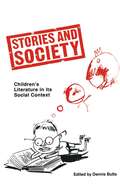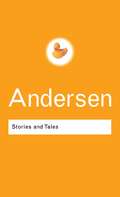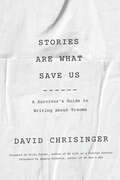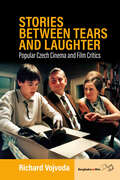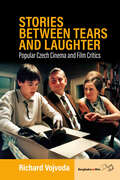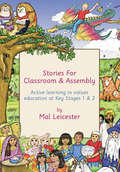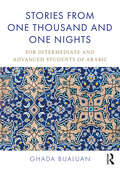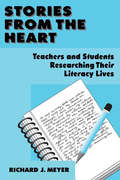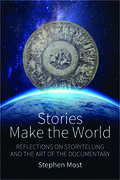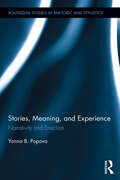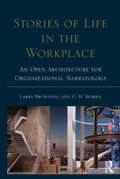- Table View
- List View
Stories and Society: Children’s Literature in its Social Context (Insights)
by Dennis ButtsChildren's literature is increasingly exposed to critical debate in England and America. There are indeed a number of histories and surveys of children's literature, but few works exist which discuss the contexts, ideologies and narrative structures of children's stories in a serious and detailed manner, or examine particular case-histories to see how the different forces interact. This is what this collection of essays attempts to do. The topics range from Little Women to Winnie the Pooh and from story forms such as 'The Adventure Story' to 'Fantasy'.
Stories and Tales
by Hans Christian AndersenA true classic of Western literature, Stories and Tales by Hans Christian Andersen, arguably the most notable children's writer of all, has delighted young and old for generations. This unique collection was first translated for George Routledge over 130 years ago. Completely reset, but preserving the original, beautiful illustrations by A.W. Bayes, engraved by the masters of Victorian book illustration, the Brothers Dalziel, this marvellous book will be treasured by young and old alike.
Stories and Tales
by Hans Christian AndersenA true classic of Western literature, Stories and Tales by Hans Christian Andersen, arguably the most notable children's writer of all, has delighted young and old for generations. This unique collection was first translated for George Routledge over 130 years ago. Completely reset, but preserving the original, beautiful illustrations by A.W. Bayes, engraved by the masters of Victorian book illustration, the Brothers Dalziel, this marvellous book will be treasured by young and old alike.
Stories and the Brain: The Neuroscience of Narrative
by Paul B. ArmstrongHow do our brains enable us to tell and follow stories? And how do stories affect our minds? In Stories and the Brain, Paul B. Armstrong analyzes the cognitive processes involved in constructing and exchanging stories, exploring their role in the neurobiology of mental functioning. Armstrong argues that the ways in which stories order events in time, imitate actions, and relate our experiences to others' lives are correlated to cortical processes of temporal binding, the circuit between action and perception, and the mirroring operations underlying embodied intersubjectivity. He reveals how recent neuroscientific findings about how the brain works—how it assembles neuronal syntheses without a central controller—illuminate cognitive processes involving time, action, and self-other relations that are central to narrative.An extension of his previous book, How Literature Plays with the Brain, this new study applies Armstrong's analysis of the cognitive value of aesthetic harmony and dissonance to narrative. Armstrong explains how narratives help the brain negotiate the neverending conflict between its need for pattern, synthesis, and constancy and its need for flexibility, adaptability, and openness to change. The neuroscience of these interactions is part of the reason stories give shape to our lives even as our lives give rise to stories.Taking up the age-old question of what our ability to tell stories reveals about language and the mind, this truly interdisciplinary project should be of interest to humanists and cognitive scientists alike.
Stories Are What Save Us: A Survivor's Guide to Writing about Trauma
by David ChrisingerA seasoned writer and teacher of memoir explores both the difficulties inherent in writing about personal trauma and the techniques for doing so in a compelling way.Since 2013, David Chrisinger has taught military veterans, their families, and other trauma survivors how to make sense of and recount their stories of loss and transformation. The lessons he imparts can be used by anyone who has ever experienced trauma, particularly people with a deep need to share that experience in a way that leads to connection and understanding. In Stories Are What Save Us, Chrisinger shows—through writing exercises, memoir excerpts, and lessons he's learned from his students—the most efficient ways to uncover and effectively communicate what you've learned while fighting your life's battles, whatever they may be. Chrisinger explores both the difficulties inherent in writing about personal trauma and the techniques for doing so in a compelling way. Weaving together his journey as a writer, editor, and teacher, he reveals his own deeply personal story of family trauma and abuse and explains how his life has informed his writing. Part craft guide, part memoir, and part teacher's handbook, Stories Are What Save Us presents readers with a wide range of craft tools and storytelling structures that Chrisinger and his students have used to process conflict in their own lives, creating beautiful stories of growth and transformation. Throughout, this profoundly moving, laser-focused book exemplifies the very lessons it strives to teach. A foreword by former soldier and memoirist Brian Turner, author of My Life as a Foreign Country, and an afterword by military wife and memoirist Angela Ricketts, author of No Man's War: Irreverent Confessions of an Infantry Wife, bookend the volume.
Stories Are What Save Us: A Survivor's Guide to Writing about Trauma
by David ChrisingerA seasoned writer and teacher of memoir explores both the difficulties inherent in writing about personal trauma and the techniques for doing so in a compelling way.Since 2013, David Chrisinger has taught military veterans, their families, and other trauma survivors how to make sense of and recount their stories of loss and transformation. The lessons he imparts can be used by anyone who has ever experienced trauma, particularly people with a deep need to share that experience in a way that leads to connection and understanding. In Stories Are What Save Us, Chrisinger shows—through writing exercises, memoir excerpts, and lessons he's learned from his students—the most efficient ways to uncover and effectively communicate what you've learned while fighting your life's battles, whatever they may be. Chrisinger explores both the difficulties inherent in writing about personal trauma and the techniques for doing so in a compelling way. Weaving together his journey as a writer, editor, and teacher, he reveals his own deeply personal story of family trauma and abuse and explains how his life has informed his writing. Part craft guide, part memoir, and part teacher's handbook, Stories Are What Save Us presents readers with a wide range of craft tools and storytelling structures that Chrisinger and his students have used to process conflict in their own lives, creating beautiful stories of growth and transformation. Throughout, this profoundly moving, laser-focused book exemplifies the very lessons it strives to teach. A foreword by former soldier and memoirist Brian Turner, author of My Life as a Foreign Country, and an afterword by military wife and memoirist Angela Ricketts, author of No Man's War: Irreverent Confessions of an Infantry Wife, bookend the volume.
Stories between Tears and Laughter: Popular Czech Cinema and Film Critics
by Richard VojvodaWhile histories of Czech cinema often highlight the quality of Czechoslovak New Wave films made in the 1960s, post-socialist Czech cinema receives little attention. Through a methodology of historical reception, Stories between Tears and Laughter explores how attitudes towards post-socialist Czech cinema have shifted from viewing it as radical “art cinema” and more towards popular cinema. By analyzing publicity materials, reviews, and articles, Richard Vojvoda offers a new perspective on the notions of cultural value and quality that have been shaping the history of post-socialist Czech cinema.
Stories between Tears and Laughter: Popular Czech Cinema and Film Critics
by Richard VojvodaWhile histories of Czech cinema often highlight the quality of Czechoslovak New Wave films made in the 1960s, post-socialist Czech cinema receives little attention. Through a methodology of historical reception, Stories between Tears and Laughter explores how attitudes towards post-socialist Czech cinema have shifted from viewing it as radical “art cinema” and more towards popular cinema. By analyzing publicity materials, reviews, and articles, Richard Vojvoda offers a new perspective on the notions of cultural value and quality that have been shaping the history of post-socialist Czech cinema.
Stories between Tears and Laughter: Popular Czech Cinema and Film Critics
by Richard VojvodaWhile histories of Czech cinema often highlight the quality of Czechoslovak New Wave films made in the 1960s, post-socialist Czech cinema receives little attention. Through a methodology of historical reception, Stories between Tears and Laughter explores how attitudes towards post-socialist Czech cinema have shifted from viewing it as radical “art cinema” and more towards popular cinema. By analyzing publicity materials, reviews, and articles, Richard Vojvoda offers a new perspective on the notions of cultural value and quality that have been shaping the history of post-socialist Czech cinema.
Stories for Classroom and Assembly: Active Learning in Values Education at Key Stages One and Two
by Mal LeicesterThis book is an indispensable resource for use in both the classroom and assembly, providing a delightful collection of fifteen original themed stories and activities, designed to develop key values and skills. Using the power of story, it stimulates reflection and discussion on a range of topics. The material is presented to maximise fun in learning, flexibility and coverage of National Curriculum guidelines for values education teaching. Amongst the key values discussed are: personal responsibility and independence co-operation and sharing honesty and justice respect for world religions. Each session contributes to key skills in English, whilst many of the activities involve use of co-ordination, numeracy and science skills. In addition, the stories are implicitly multicultural in flavour, giving a diverse and innovative feel to the book as a whole. An irresistibly charming, and yet practical tool, its topical tales and photocopiable resources make it an essential classroom companion.
Stories for Classroom and Assembly: Active Learning in Values Education at Key Stages One and Two
by Mal LeicesterThis book is an indispensable resource for use in both the classroom and assembly, providing a delightful collection of fifteen original themed stories and activities, designed to develop key values and skills. Using the power of story, it stimulates reflection and discussion on a range of topics. The material is presented to maximise fun in learning, flexibility and coverage of National Curriculum guidelines for values education teaching. Amongst the key values discussed are: personal responsibility and independence co-operation and sharing honesty and justice respect for world religions. Each session contributes to key skills in English, whilst many of the activities involve use of co-ordination, numeracy and science skills. In addition, the stories are implicitly multicultural in flavour, giving a diverse and innovative feel to the book as a whole. An irresistibly charming, and yet practical tool, its topical tales and photocopiable resources make it an essential classroom companion.
Stories from One Thousand and One Nights: For Intermediate and Advanced Students of Arabic
by Ghada BualuanSpecially designed for students of Arabic, this textbook presents a selection of authentic Arabian Night stories in simplified language providing learners of Modern Standard Arabic access to this classic of Arabic literature. Each story is fully supported by a range of comprehension, vocabulary-building, grammar reinforcement activities and exercises as well as an audio version of the story, which can be accessed at www.routledge.com/9781138948228. Ideal for class-use or self-study, students will enhance their reading, listening, and writing skills while developing the ability to analyze literary texts, reason critically, and broaden their understanding and appreciation of different layers of Arab culture.
Stories from One Thousand and One Nights: For Intermediate and Advanced Students of Arabic
by Ghada BualuanSpecially designed for students of Arabic, this textbook presents a selection of authentic Arabian Night stories in simplified language providing learners of Modern Standard Arabic access to this classic of Arabic literature. Each story is fully supported by a range of comprehension, vocabulary-building, grammar reinforcement activities and exercises as well as an audio version of the story, which can be accessed at www.routledge.com/9781138948228. Ideal for class-use or self-study, students will enhance their reading, listening, and writing skills while developing the ability to analyze literary texts, reason critically, and broaden their understanding and appreciation of different layers of Arab culture.
Stories From the Heart: Teachers and Students Researching their Literacy Lives
by Richard J. MeyerStories from the Heart is for, by, and about prospective and practicing teachers understanding themselves as curious and literate beings, making connections with colleagues, and researching their own literacy and the literacy lives of their students. It demonstrates the power and importance of story in our own lives as literate individuals. Readers are encouraged to: tell, write, or re-create the stories of their literacy lives in order to understand how they learn and teach; begin the journey into writing the stories of others' literacy lives; find support in their researching endeavors; and examine the idea of framing stories by using the work of other teachers and researchers.
Stories From the Heart: Teachers and Students Researching their Literacy Lives
by Richard J. MeyerStories from the Heart is for, by, and about prospective and practicing teachers understanding themselves as curious and literate beings, making connections with colleagues, and researching their own literacy and the literacy lives of their students. It demonstrates the power and importance of story in our own lives as literate individuals. Readers are encouraged to: tell, write, or re-create the stories of their literacy lives in order to understand how they learn and teach; begin the journey into writing the stories of others' literacy lives; find support in their researching endeavors; and examine the idea of framing stories by using the work of other teachers and researchers.
Stories in Action: Interactive Tales and Learning Activities to Promote Early Literacy
by William GordhPromote the love of story, familiarize children with a variety of story forms and stimulate curiosity in diverse subjects while building basic literacy skills. In this guide, dozens of enchanting stories from around the world are accompanied by simple learning extensions for children (ages 4 through 8) that build such important literacy skills as print awareness, print motivation, vocabulary, phonological awareness, listening skills, and predicting and sequencing skills. Each of the 14 chapters begins with an interactive, illustrated folktale finger play as the starting point for a range of literacy building activities such as acting out, re-telling, writing, and discussions; and ends with a short list of related books. A great resource for library story hour, the book will also be invaluable to storytellers, teachers, day care centers, and after school programs. Grades PreK-3.Enchant children with these interactive stories while building a solid foundation for literacy in young learners. This guide is designed to promote in children (ages 4 through 8) the love of story, familiarize them with a variety of story forms, stimulate curiosity in diverse subjects, and build literacy skills. It offers approximately 40 engaging and interactive tales from around the world along with related activities, and it provides educators and storytellers with a wealth of exciting material for literacy and storytelling programs. The book is organized in three sections-Exploring Structures of Stories, Exploring Themes and Characters through Stories, and Exploring Cultures through Stories. Each of the 14 chapters begins with an interactive, illustrated folktale finger play as starting point for a range of literacy building activities such as acting out, re-telling, writing, and discussions. Related stories and picture book references build upon such themes as tall tales, sharing, magical helpers, and the rain forest. Tips for working with younger children, as well as gifted and older children are also included. Grades PreK-3.
Stories Make the World: Reflections on Storytelling and the Art of the Documentary
by Stephen MostSince the beginning of human history, stories have helped people make sense of their lives and their world. Today, an understanding of storytelling is invaluable as we seek to orient ourselves within a flood of raw information and an unprecedented variety of supposedly true accounts. In Stories Make the World, award-winning screenwriter Stephen Most offers a captivating, refreshingly heartfelt exploration of how documentary filmmakers and other storytellers come to understand their subjects and cast light on the world through their art. Drawing on the author’s decades of experience behind the scenes of television and film documentaries, this is an indispensable account of the principles and paradoxes that attend the quest to represent reality truthfully.
Stories, Meaning, and Experience: Narrativity and Enaction (Routledge Studies in Rhetoric and Stylistics)
by Yanna B. PopovaThis is a book about the human propensity to think about and experience the world through stories. ‘Why do we have stories?’, ‘How do stories create meaning for us?’, and ‘How is storytelling distinct from other forms of meaning-making?’ are some of the questions that this book seeks to answer. Although these and other related problems have preoccupied linguists, philosophers, sociologists, narratologists, and cognitive scientists for centuries, in Stories, Meaning, and Experience, Yanna Popova takes an original interdisciplinary approach, situating the study of stories within an enactive understanding of human cognition. Enactive approaches to consciousness and cognition foreground the role of interaction in explanations of social understanding, which includes the human practices of telling and reading stories. Such an understanding of narrative makes a decisive break with both text-centred approaches that have dominated structuralist and early cognitivist views of narrative meaning, as well as pragmatic ones that view narrative understanding as a form of linguistic implicature. The intersubjective experience that each narrative both affords and necessitates, the author argues, serves to highlight the active, yet cooperative and communal, nature of human sociality, expressed in the numerous forms of human interaction, of which storytelling is one.
Stories, Meaning, and Experience: Narrativity and Enaction (Routledge Studies in Rhetoric and Stylistics)
by Yanna B. PopovaThis is a book about the human propensity to think about and experience the world through stories. ‘Why do we have stories?’, ‘How do stories create meaning for us?’, and ‘How is storytelling distinct from other forms of meaning-making?’ are some of the questions that this book seeks to answer. Although these and other related problems have preoccupied linguists, philosophers, sociologists, narratologists, and cognitive scientists for centuries, in Stories, Meaning, and Experience, Yanna Popova takes an original interdisciplinary approach, situating the study of stories within an enactive understanding of human cognition. Enactive approaches to consciousness and cognition foreground the role of interaction in explanations of social understanding, which includes the human practices of telling and reading stories. Such an understanding of narrative makes a decisive break with both text-centred approaches that have dominated structuralist and early cognitivist views of narrative meaning, as well as pragmatic ones that view narrative understanding as a form of linguistic implicature. The intersubjective experience that each narrative both affords and necessitates, the author argues, serves to highlight the active, yet cooperative and communal, nature of human sociality, expressed in the numerous forms of human interaction, of which storytelling is one.
Stories of Becoming: Demystifying the Professoriate for Graduate Students in Composition and Rhetoric
by Claire Lutkewitte Juliette C. Kitchens Molly J. ScanlonBased on findings from a multiyear, nationwide study of new faculty in the field of rhetoric and composition, Stories of Becoming provides graduate students—and those who train them—with specific strategies for preparing for a career in the professoriate. Through the use of stories, the authors invite readers to experience their collaborative research processes for conducting a nationwide survey, qualitative interviews, and textual analysis of professional documents. Using data from the study, the authors offer six specific strategies—including how to manage time, how to create a work/life balance, and how to collaborate with others—that readers can use to prepare for the composition and rhetoric job market and to begin their careers as full-time faculty members. Readers will learn about the possible responsibilities they may take on as new faculty, particularly those that go beyond teaching, research, service, and administration to include navigating the politics of higher education and negotiating professional identity construction. And they will also engage in activities and answer questions designed to deepen their understanding of the field and help them identify their own values and desired career trajectory. Stories of Becoming demystifies the professoriate, compares what current new faculty have to say of their job expectations with the realities that students might face when on the job, and brings to light the invisible, behind-the-scenes work done by new faculty. It will be invaluable to graduate students, those who teach graduate students, new faculty, and hiring administrators in composition and rhetoric.
The Stories of English: A Verb's-eye View Of The English Language
by David CrystalWhen and why did 'thou' disappear from Standard English? Would a Victorian Cockney have said 'observation' or 'hobservation'? Was Jane Austen making a mistake when she wrote 'Jenny and James are walked to Charmonth this afternoon'?This superbly well-informed - and also wonderfully entertaining - history of the English language answers all these questions, showing how the many strands of English (Standard English, dialect and slang among them) developed to create the richly-varied language of today.
Stories of Life in the Workplace: An Open Architecture for Organizational Narratology (Routledge Communication Series)
by Larry Browning George H. MorrisAddressing both renowned theories and standard applications, Stories of Life in the Workplace explains how stories affect human practices and organizational life. Authors Larry Browning and George H. Morris explore how we experience, interpret, and personalize narrative stories in our everyday lives, and how these communicative acts impact our social aims and interactions. In pushing the boundaries of how we perceive narrative and organization, the authors include stories that are broadly applicable across all concepts and experiences. With a perception of narrative and its organizational application, chapters focus on areas such as pedagogy, therapy, project management, strategic planning, public communication, and organizational culture. Readers will learn to: differentiate and gain an in-depth understanding of perspectives from varying narrators; recognize how stories are constructed and used in organizations, and modify the stories they tell; view stories as a means to promote an open exchange of creativity. By integrating a range of theories and practices, Browning and Morris write for an audience of narrative novices and scholars alike. With a distinctive approach and original insight, Stories of Life in the Workplace shows how individuality, developing culture, and the psychology of the self are constructed with language—and how the acceptance of one’s self is accomplished by reaffirming and rearranging one’s story.
Stories of Life in the Workplace: An Open Architecture for Organizational Narratology (Routledge Communication Series)
by Larry Browning George H. MorrisAddressing both renowned theories and standard applications, Stories of Life in the Workplace explains how stories affect human practices and organizational life. Authors Larry Browning and George H. Morris explore how we experience, interpret, and personalize narrative stories in our everyday lives, and how these communicative acts impact our social aims and interactions. In pushing the boundaries of how we perceive narrative and organization, the authors include stories that are broadly applicable across all concepts and experiences. With a perception of narrative and its organizational application, chapters focus on areas such as pedagogy, therapy, project management, strategic planning, public communication, and organizational culture. Readers will learn to: differentiate and gain an in-depth understanding of perspectives from varying narrators; recognize how stories are constructed and used in organizations, and modify the stories they tell; view stories as a means to promote an open exchange of creativity. By integrating a range of theories and practices, Browning and Morris write for an audience of narrative novices and scholars alike. With a distinctive approach and original insight, Stories of Life in the Workplace shows how individuality, developing culture, and the psychology of the self are constructed with language—and how the acceptance of one’s self is accomplished by reaffirming and rearranging one’s story.
The Stories of Linguistics: An Introduction To Language Study Past And Present (PDF)
by Kim BallardWhat is the nature of human language? How did it originate? How did it come to be so diverse and what are the connections between the thousands of global languages? How do we learn language? Stories of Linguistics explores the people, ideas and events that have shaped linguistic thought and research for more than two thousand years.
The Stories of Linguistics: An Introduction to Language Study Past and Present
by Kim BallardWhat is the nature of human language? How did it originate? How are different languages connected?Exploring over two thousand years of human enquiry, The Stories of Linguistics is an accessible introduction to the individuals, ideas and events that have shaped the field of linguistics. From Herodotus to Chomsky, and from philosophy to neuroscience, Kim Ballard presents a fascinating narrative that brings to life a dynamic subject with a rich history. The Stories of Linguistics:uses a thematic rather than a traditional chronological approach to explore the complex development of Western linguistics offers an accessible introduction to a field of linguistics which is attracting more and more interestguides readers seamlessly through linguistic history, supported by timelines and suggestions for further reading and researchWith its broad scope and conversational style, The Stories of Linguistics is an ideal introductory text for students at every level, as well as anyone else with an interest in the history and development of language.
